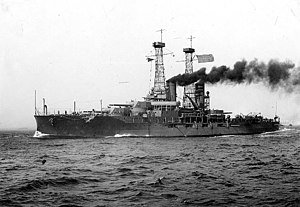Delaware-class battleship

USS North Dakota, the second ship of the class
|
|
| Class overview | |
|---|---|
| Name: | Delaware-class battleship |
| Builders: | |
| Operators: |
|
| Preceded by: | South Carolina class |
| Succeeded by: | Florida class |
| In commission: | 1910–1923 |
| Planned: | 2 |
| Completed: | 2 |
| Retired: | 2 |
| Preserved: | 0 |
| General characteristics | |
| Type: | Battleship |
| Displacement: | |
| Length: | |
| Beam: | 85 ft 3 in (26 m) |
| Draft: |
|
| Propulsion: |
|
| Speed: | 21 kn (24 mph; 39 km/h) |
| Range: | 6,000 nmi (11,000 km) at 10 kn (12 mph; 19 km/h) |
| Complement: | 933 officers and men |
| Armament: | |
| Armor: | |
The Delaware-class battleships of the United States Navy were the second class of American dreadnoughts. With this class, the 16,000 long tons (16,257 t) limit imposed on capital ships by the United States Congress was waived, which allowed designers at the Navy's Bureau of Construction and Repair to correct what they considered flaws in the preceding South Carolina class and produce ships not only more powerful but also more effective and rounded overall. Launched in 1909, these ships became the first in US naval history to exceed 20,000 long tons (20,321 t).
The Delawares carried a battery of ten 12-inch (305 mm) guns in five turrets, an increase of two guns over the South Carolinas. With these ships, the US Navy re-adopted a full-fledged medium-caliber weapon for anti-torpedo boat defense. While the 5-inch (127 mm) gun was smaller than that used by other major navies, this would, with few exceptions, become the standard medium-gun caliber for the US Navy for the better part of the 20th century. As for speed, the Delawares were capable of 21 kn (24 mph; 39 km/h), a significant improvement over the earlier class's 18.5 kn (21 mph; 34 km/h). This would become the speed for all American standard-type battleships. Propulsion systems were mixed; while North Dakota was fitted with steam turbines, Delaware retained triple-expansion engines. US turbines at this point did not give great advantages in output or speed over triple-expansion systems, as turbine manufacturers in the US still faced great engineering difficulties. Turbines were also much less fuel-efficient, a significant concern for a Navy with Pacific responsibilities but lacking Britain's extensive network of coaling stations.
...
Wikipedia
